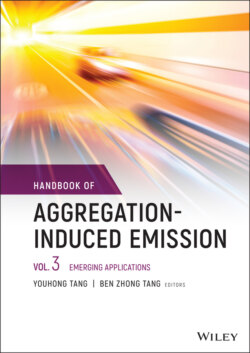Читать книгу Handbook of Aggregation-Induced Emission, Volume 3 - Группа авторов - Страница 45
3.5 Conclusions
ОглавлениеSince the discovery of the first AIEgen, enormous and conspicuous advancements have been made in many sectors and field of science. In the closing remarks of the Faraday discussion on AIE held in Guangzhou, China, in November 2016, Bin Liu properly described the history of the AIE phenomenon from its discovery and mechanistic studies to real‐life applications in optoelectronics, environmental monitoring, and biomedical research [114]. This inspiring talk illuminated several authors in providing AIEgens with even more intriguing characteristics and applications. In this regard, this contribution aimed to convince the readership about the potential offered by the AIE technology in producing fluorescent plastic films that are able to provide optical outputs to be used in sensing applications or in the energy field for solar harvesting. The AIEgens prove to be the best candidates to dope polymer films due to their high brilliant and high emission in the solid state that can be easily perturbed by external solicitations such as a mechanical, thermal, or chemical stress. OFF–ON fluorescence outputs were demonstrated to be more appealing than the corresponding ON–OFF ones since easily detectable responses with high contrast can be gathered. The AIE technology not only paved the way for practical sensing applications but also enabled the design and realization of highly luminescent polymer films in solar harvesting. LSCs appear as one of the most promising solutions to increase the diffusion of the PVs in the urban environment. A high ΦF and a well‐compatible AIEgen with low autoabsorption losses were demonstrated to be the perfect candidates to dope plastic films and slabs to maximize sunlight collection and increase the optical efficiency. In conclusion, the versatile chemistry of AIEgens will enable the preparation of even more efficient fluorophores that will be helpful in many fields of science, comprising polymeric materials.
